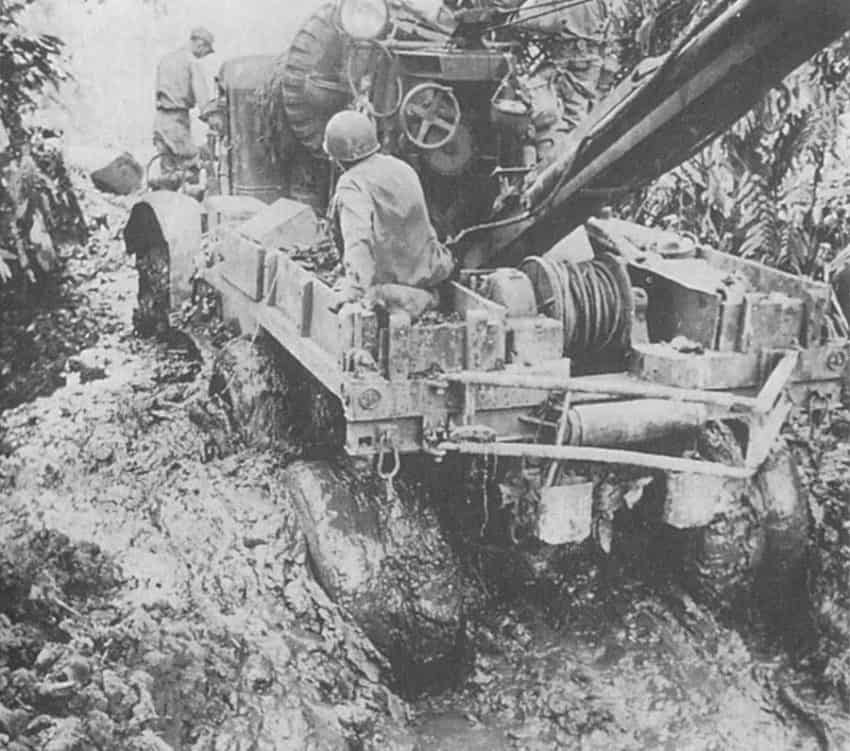
The U.S. Sixth Army was tasked with the mission to capture Saidor, as part of Operation Dexterity. This was done to take advantage of the recent success of the Australian 9th Division at Finschhafen. An American blocking position at Saidor would cut off the Japanese retreat from Finschhafen, and would trap an entire Japanese division at Sio. For more detail, click on the source, the 32nd Divisions website.
By Phil Kohn. Dedicated to the memory of his father, GM3 Walter Kohn, U.S. Navy Armed Guard, USNR, and all men and women who have answered the country’s call in time of need. Phil can be contacted at ww2remembered@yahoo.com.
Adolf Hitler, in a New Year’s message to the German people on December 31, 1943, admits that 1943 “brought us our heaviest reverses,” and cautions that 1944 “will make heavy demands on all Germans.” He adds, however, that “we have every confidence that we will survive.” Allied merchant shipping sunk by U-boats worldwide from January 1 to December 31, 1943, totals 588 ships, equaling 3,042,371 gross tons. In the same period, 242 German U-boats have been lost.
On January 1, 1944, partly the result of his slapping soldiers in hospitals on two occasions in Sicily in August 1943 (and mostly because Gen. Eisenhower wants him to be part of the invasion of France), Lt. Gen. George S. Patton is replaced by Lt. Gen. Mark W. Clark as commander of the U.S. Seventh Army. (Clark retains command of the U.S. Fifth Army as well.) In North Africa, the first — and only — “Arab Bowl” football game is played at San Felipe Stadium in Oran, Algeria. Attended by 15,000 Allied military personnel, the game features teams made up of U.S. soldiers and sailors stationed in the area. Army beats Navy, 10-7. RAF Bomber Command dispatches 421 bombers on a night raid on Berlin. In the U.S., the Treasury stops minting zinc-coated steel pennies, resuming the striking of copper coins. In the Pacific, carrier-based American planes attack a Japanese convoy off Kavieng, New Ireland.
U.S. Marines and soldiers of the U.S. Sixth Army on January 2 land at Saidor, in northern New Guinea, and begin to drive up the coast. The loss of Saidor means that 20,000 Japanese soldiers are sandwiched between Australian and U.S. forces. In Germany, Berlin’s Reich Chancellery is reported 75% destroyed, with many people trapped in the shelters below the building after a direct hit during the overnight RAF raid on the city.
British Gen. Bernard Montgomery — back in Britain from Italy — on January 3 takes command of the 21stArmy Group as the Allied commander-in-chief of all ground forces during “Operation Overlord,” the planned invasion of Normandy. He will report to the Supreme Allied Commander of the Allied Expeditionary Forces, U.S. Gen. Dwight D. Eisenhower. The British Eighth Army, Montgomery’s former command in Italy, is now headed by Lt. Gen. Oliver Leese. Near Ambrose Light, off the New Jersey coast, the U.S. Navy destroyer USS Turnerexperiences a series of internal explosions (likely in her ammunition lockers) that cause the vessel to capsize and sink, taking her 15 officers and 123 of her 260 crewmen down with her. Survivors — some in critical condition — are rescued by nearby ships and taken to Sandy Hook, New Jersey. U.S. Coast Guard Lt. Cdr. Frank Erickson flies two cases of urgently needed blood plasma from New York to Sandy Hook strapped to the pontoons of his Sikorsky HNS-1 helicopter. It is the first use of a helicopter in a life-saving role.
In Italy, the U.S. Fifth Army attacks the German Gustav Line across a 10-mile front on January 4. In Germany, the government announces the mobilization of school children for war work. Elsewhere in Europe, “Operation Carpetbagger” begins: The Allies will provide regular air-dropped supplies to resistance groups in the Netherlands, Belgium, France and Italy. In London, the exiled King of Greece strips three former prime ministers of their Greek citizenship for collaborating with the German occupation authorities. The Red Army’s 1stUkrainian Front pushes Field Marshal Erich von Manstein’s Army Group South back across the pre-war Polish border at Sarny, in western Ukraine.
As part of the Red Army’s plan to recover western Ukraine and the Crimea, Gen. Ivan Konev’s 2nd Ukrainian Front on January 5 launches an offensive toward Kirovgrad. The London-based Polish government-in-exile authorizes the Polish underground movement to cooperate with the Red Army only in the event of a resumption of Polish-Soviet relations. (The Soviet government has not yet recognized the Polish government-in-exile.)
The Red Army on January 6 crosses what had been the 1939 Polish frontier after advancing 170 miles in just two weeks. The Allies announce that jet-propelled aircraft will soon be in production. The British Air Ministry says that Bomber Command dropped 157,000 tons of bombs on Germany in 1943, while the Luftwaffedropped only 2,400 tons of ordnance on Britain. In Burma, U.S. Army Brig. Gen. Frank Merrill is named to command a volunteer, long-range-penetration assault unit, dubbed by war correspondents as “Merrill’s Marauders.”


